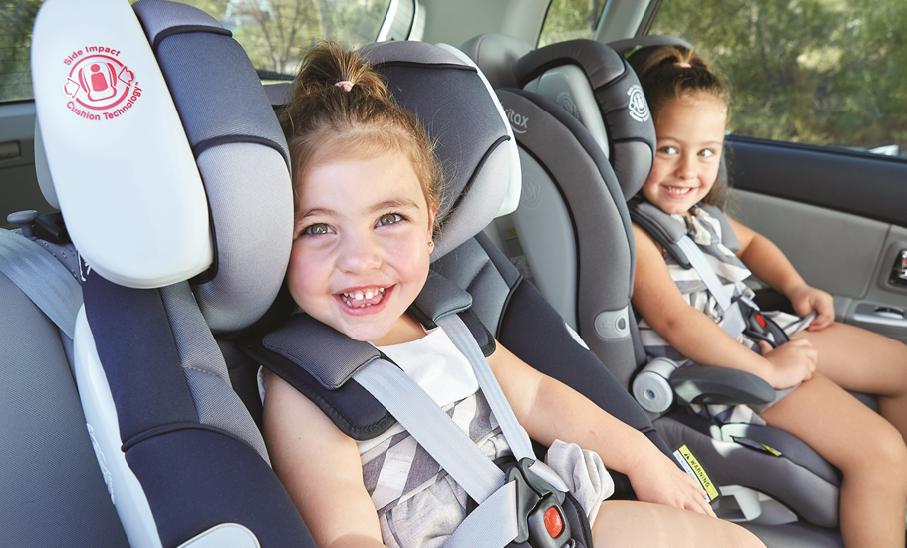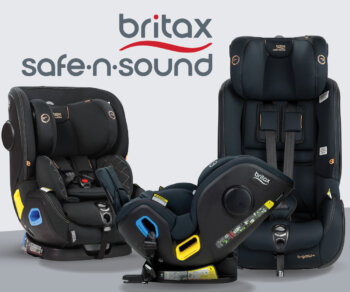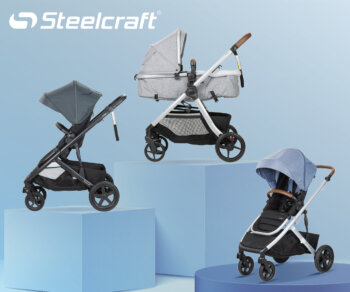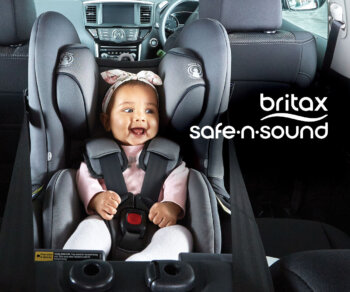Media kindly brought to you by Britax
If you’re preparing to fit your child into their very first car seat or upgrading to a new one, confusion and worry can set in: ‘what if I install it wrong?’. It’s a common concern amongst parents who are still growing accustomed to using child restraints, and for good reason. Testing from Transurban and Kidsafe during their ‘Car Seat Safety Blitz’ in May of this year, indicates that 40% of child restraints are used in a way that would impair crash performance, and that two or more fitting and installation errors often happen simultaneously. Clearly, the stakes couldn’t be higher, with car seat use among the most important factors in your child’s safety and wellbeing during early childhood.
It’s useful to think of child car safety as involving the 3 key aspects; the restraint is the right size for the child, the restraint is correctly fitted to the vehicle, and the child is securely placed in the restraint. It’s a parent or caregiver’s job to make sure that all 3 elements are ticked off for each and every journey your child makes. It may sound daunting, but Kiddipedia has teamed up with the experts at Britax to compile a list of crucial do’s and don’ts in fitting your child in a car seat.
With a proud 50+ year history and production of over 10 million car seats keeping little ones safe, Britax is an industry leader in the design and manufacture of child car restraints and other travel systems that are trusted the world over. Here, they explain what parents and caregivers can do to maximise safety precautions, maintain the intended operation of the car seat, and ensure the needs of their child are always met.
DO choose a car that has been safety tested to Australian standards
Choosing a quality car seat that meets Australian regulations is absolutely crucial and the foundation for your child’s safety in the car. Before making a purchase, the car seat in question *must* display the AS/NZS 1754 certification label to indicate it has been properly tested for Australian vehicles.
Did you know it’s actually illegal in Australia to buy a car restraint that doesn’t meet these standards? One reason for this is that Australian vehicles contain a unique top-tether strap anchorage system that is not compatible with foreign child restraints. The second reason is that Australian testing is more rigorous than most international standards, including side and rear impact tests, and in some cases even allows for an inverted test for roll-over protection. Therefore, avoid shopping for overseas stock and enjoy the peace of mind that the Australian standard offers.
And before making that final decision on your child’s restraint, it pays to research how the testing conditions have informed the product. Britax operates one of four crash-test sleds in Australia, and their rigorous commitment to testing has led to development of their world-class Side Impact Cushion Technology (SICT™) and ACTIVE HEAD RESTRAINT (AHR™) technology.
DO ensure the car seat meets your child’s needs
It’s common for new and even more seasoned parents to be unsure about which car seat is appropriate for the age and size of their child, and unfamiliar with the regulations that govern it. Britax explains that parents and caregivers should follow the national safety road laws combined with manufacturer’s instructions on which car seat to use, and outlines the official advice as it relates to children’s age progression and the appropriateness of different restraints:
- Children under the age of six months must use a rear facing car seat
- Children aged six months to four years can use either a rear facing car seat or a forward-facing car seat.
- Children aged four years to seven years (approx.) must travel in a forward-facing car seat or booster seat. Although staying in a harnessed seat is the safest option.
They go on to caution that age is only a guide, and emphasise that the height of your child is a much better benchmark of whether a car seat meets their needs: “A common mistake parents make is progressing to the next type of car seat based on age rather than height. Size of a child can vary, and not all 4-year-olds are the same height. Children should fit within the shoulder height marker advice for the specific model of car seat they are using.” For instance, rather than changing from rear to forward-facing at the 6-month minimum, Britax recommends for your child to remain in a rear-facing seat or position until their shoulder is in-line with or above the forward-facing height marker. Read more about the benefits of rear-facing seats, here.
DO consider a professional fitting
It’s natural for an anxious parent or caregiver to think that they’re the only one struggling with car seat installation, but that’s simply not the case. In fact, it’s been reported that over 50% of child restraints are not fitted correctly, with Royal Automotive Club of Victoria (RACV) data suggesting the figure is as high as 70%. For this reason, it’s strongly recommended to get a professional car seat fitting if you’re in a position to do so. It’s especially important if you’re not confident about how to comply with manufacturer guidelines in the use of your car seat, or have any doubts about its suitability for your car.
Even if you’re fairly convinced that you’ve got the restraints installed correctly, it’s worth getting it checked over by a professional to ensure you’re not before repeating a mistake that could seriously affect the performance of the car seat and undermine its safety benefits if the worst were to occur. If you’re wondering where to get help, members of the Australian Automobile Association operating in every Australian state make such services available, and Kidsafe’s ‘Find a Fitter program’ offers an online search portal to locate child restraint fitting stations.
DO follow manufacturer’s instructions
It may seem obvious, but it bears repeating that every parent or caregiver should consult the manufacturer’s guide in order to install the car seat itself and their child within it. This is not the time for guesswork, as deviating from the instructions could impair the safety design and expose your child to risk. Despite some similarities, car seat models and makes are constructed differently, so don’t assume that advice is interchangeable across brands. Furthermore, overlooking the usage guidelines of your car seat could void the warranty.
Getting skilled and confident from the outset will limit the chance of mistakes and make any subsequent fittings easier, with harness and strap fitting in particular needing to become routine. As Britax advises: “Some car seats also feature harnesses that do not require threading/unthreading thus enabling automatic shoulder height repositioning. As you will be dealing with straps every day, these are important features that make using a car seat easier and less stressful.” Ease of use is incorporated throughout the entire Britax range, with the popular Britax Safe-n-Sound B-First (birth – four years (approx.) offering a unique, patented Clicktight Installation System™ that is designed to provide effortless and secure installation every time, and reduce the chance of misuse.
DON’T install at an unsafe angle
For infant carriers or rear-facing car seats, installing at the right angle is crucial to getting your baby’s head positioned comfortably on the back of the car seat. Britax sheds some more light on getting this right: “The preferred angle of a rear facing car seat base is 10-15°, for vehicles with a flatter car seat you can pack firmly rolled up towels on the underside of the base to achieve the desired angle.” Some car seats – including the Britax B family range of products, ffeature levelling indictors that easily allow you to ensure you’re installing the seat at the correct angle.
And depending on your lifestyle, consider that fitting the car seat itself may not be a ‘set once and forget’ scenario. For instance, there may be a need to move the car seat into a grandparent or other family member’s vehicle, and back to your own again. If in any doubt about getting it right, a professional fitting can help you get back on track.
Finally, remember that the safest placement of a car seat is the middle position of the vehicle’s backseat, as it protects your child in the event of a side-impact collision. An alternative option is to install the car seat at the rear passenger side of your vehicle.
DON’T forget to make regular safety checks
If there’s one constant in child car seat safety, it’s surely vigilance. Buying a top-of-the-line car seat will bring immeasurable benefit, but still requires ongoing checks to ensure it’s performing as intended and that user error has not come into play. Among the misuse problems identified in Transurban and Kidsafe’s above mentioned ‘Safety Blitz’ report, two of these – loose or twisted seat belts and tether straps twisted or not fastened correctly to an anchor point – especially speak to the basic yet common nature of car seat risks.
We know how busy parents and caregivers can get, but it’s always worth taking the extra 2 minutes to check things over before setting out on a journey with your child. Whether it’s installing the restraint to the rear seat again after it’s been moved, or just fitting a child into it for another outing, Britax reminds us all: “make sure the car seat is secured tightly to your vehicle with no more than a couple of centimetres movement from back to front or side to side.” You must also get used to regularly checking the height of your child against the markers on their seat, to ensure the harness and headrest are fitting as they should throughout your child’s growth and able to best sustain impact from a crash.
Last but certainly not least, regularly check the straps, buckles and adjusters for any signs of wear and damage, and call the manufacturer if they emerge.
It’s no exaggeration to say that a properly fitted car seat could mean the difference between the life and death of a child in a road accident. By reading this article, you’ve demonstrated the desire to stay informed on how to do it right, and by acting on this and other expert advice, you are well on the way to travelling safely with your child! For more information and to learn more about the fabulous products in the Britax range, check out the Britax website.









